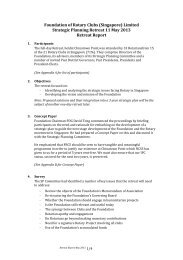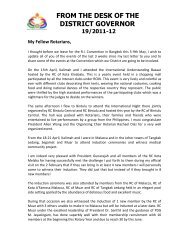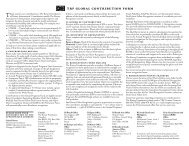haemodialysis_quality_standards - Rotary International District 3310
haemodialysis_quality_standards - Rotary International District 3310
haemodialysis_quality_standards - Rotary International District 3310
Create successful ePaper yourself
Turn your PDF publications into a flip-book with our unique Google optimized e-Paper software.
If a common supply cart is used to store clean supplies in the patient treatment area,<br />
<br />
to avoid contamination with blood. Such carts shall not be moved between stations to<br />
distribute supplies.<br />
Staff members shall wear gowns, face shields, eye wear, or masks to protect themselves<br />
and prevent soiling of clothing when performing procedures during which spurting or<br />
spattering of blood might occur (e.g., during initiation and termination of dialysis, cleaning<br />
of dialyzers, and centrifugation of blood).<br />
Such protective clothing or gear shall be changed if it becomes soiled with blood, body<br />
<br />
Staff members shall not eat, drink, or smoke in the dialysis treatment area or in the<br />
laboratory.<br />
Patients can be served meals or eat food brought from home at their dialysis station. The<br />
glasses, dishes, and other utensils shall be cleaned in the usual manner; no special care<br />
of these items is needed.<br />
Establish written protocols for cleaning and disinfecting surfaces and equipment in the<br />
dialysis unit, including careful mechanical cleaning before any disinfection process. If the<br />
manufacturer has provided instructions on sterilization or disinfection of the item, these<br />
instructions shall be followed. For each chemical sterilant and disinfectant, follow the<br />
<br />
After each patient treatment, clean environmental surfaces at the dialysis station,<br />
including the dialysis bed or chair, countertops, and external surfaces of the dialysis<br />
machine, including containers associated with the prime waste. Use any soap, detergent,<br />
or detergent germicide.<br />
Between uses of medical equipment (e.g., scissors, haemostats, clamps, stethoscopes,<br />
blood pressure cuffs), clean and apply a hospital disinfectant (i.e., low-level disinfection);<br />
if the item is visibly contaminated with blood, use a tuberculocidal disinfectant (i.e.,<br />
intermediate-level disinfection).<br />
For a blood spill, immediately clean the area with a cloth soaked with a tuberculocidal<br />
disinfectant or a 1:100 dilution of household bleach (300-600 mg/L free chlorine) (i.e.,<br />
intermediate-level disinfection). The staff member doing the cleaning shall wear gloves,<br />
and the cloth shall be placed in a bucket or other leak proof container.<br />
Haemodialysis Quality and Standards 49
















